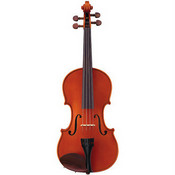Your shopping cart is currently empty.
If you have not already done so, you can login to your account to see any items that may be saved in your cart. Once logged in, you may also add items to the cart that you saved previously to your wishlist.
Instrument Overview

The violin is a member of the string instrument family. Sound on the violin is produced by moving the bow across the strings, or by plucking the strings. The violin may be best known as an orchestra instrument, but it is also an important bluegrass instrument and is used in a variety of genres, including country music. The term "fiddle" is just another name for the violin.
These are general guidelines for help in determining the correct instrument size. The best option is to have the teacher size the student, and always defer to the teacher's judgment in sizing. It is important for the player to be comfortable to avoid issues that may develop over time from playing an improperly sized instrument.
The chart below is a good guideline for violin sizing. Have the player stand with left arm fully extended to the side, then measure the distance from the neck to the middle of the palm. Refer to the chart to determine the best size. The student's age may also give you some idea of the size. Remember that everyone grows at a different rate. It is important for the player to be comfortable to avoid physical issues.
When supporting the instrument under the chin in playing position, if the instrument is the proper size, the palm and fingers of the left hand should be able to comfortably cup the scroll.
| Violin Size | Arm Length | Player's Age |
|---|---|---|
| 1/16 | 14"-15" | 3 to 4 years old |
| 1/10 | 15"-17" | 4 to 5 years old |
| 1/8 | 17"-18" | 5 to 6 years old |
| 1/4 | 18"-20" | 6 to 7 years old |
| 1/2 | 20"-22" | 8 to 9 years old |
| 3/4 | 22"-23" | 10 to 11 years old |
| 4/4 | 23"+ | 12 years and older |
7/8 size violins are also available by special request. These are sometimes used by smaller adults or people with small hands.
Other Resources
Violin Facts